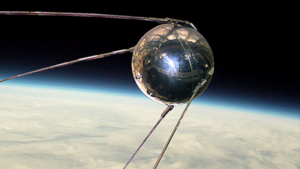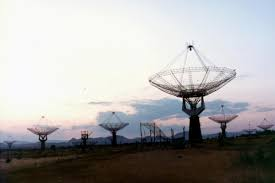Science > Physics > Astronomical Physics > Artificial Satellites
In this article, we shall study about artificial satellites and their uses.
Natural satellites are heavenly bodies revolving around a planet in their fixed orbits. They are comparatively larger in size and their orbits have larger radii. Their surfaces are made of rocky mountains or gas.
Artificial satellites revolve around the earth much closer than the moon. They are man-made bodies fitted with sophisticated instruments and cameras and made to rotate around their planets in pre-fixed orbits. They are launched using rockets in the orbit from the earth.
Sputnik – I was the first artificial satellite launched on 4 th October 1997 by the Soviet Union. It was very small in size (58 cm in diameter), weighed only 83.6 kg. and took about 98 minutes to orbit the Earth on its elliptical path.

Yuri Gagarin of the Soviet Union of Russia was the first man to travel in space. A beach Lyka was the first animal to travel in a space.
Indian Progress:
Aryabhatta was the first Indian satellite launched on 19 th April 1975 by Russian rocket SOYUZ from the Russian launch pad at Baikonur. Some other artificial satellites are INSAT (Indian National Satellite), IRS (Indian Remote Sensing satellites) Kalpana – I, Edusat, GSat etc.
In India, the space research is done by ISRO (Indian Space Research Organization). ISRO’s CHANDRAYAN project has great success. It has found water on the surface of the moon for the first time. India had successfully launched a spacecraft called Mangalyaan to Mars.
Indian satellites are projected in the space from Shri Harikota near Andhrapradesh. This facility is also known as Satish Dhawan Space Centre. A new facility is coming at Chandipur in Orissa. India has developed series of rockets SLV (Satellite Launch Vehicle), ASLV (Augmented Satellite Launch Vehicle), PSLV (Polar Satellite Launch Vehicle), GSLV (Geostationary Satellite Launch Vehicle) etc. Using this technology we have developed missiles like Nag, Akash, Dhanush, Prithvi, Agni. Agni – III is ICBM (Intercontinental Ballistic Missile) with the range of about 5000 km.
Rakesh Sharma was the first Indian Astronaut to travel in space. Kalpana Chawla was first Indian origin US citizen to work in space.
Uses of Artificial Satellites:
- Making contact with things in space and for communication.
- Weather forecasting
- Telecommunications and broadcasting programs on radio and television.
- Conducting space research.
- Implementing educational programs.
- Making accurate maps.
Types of Satellites:
Communication Satellites:
A communication satellite is a satellite which revolves around the earth in earth’s equatorial plane in the same direction of rotation of the earth in 24 hours. The approximate height of such a satellite from the surface of the earth is about 36000 km. As it appears to be stationary with respect to an observer on the earth, the communication satellite is also called as the geostationary or geosynchronous satellite. e.g. INSAT series satellites.
Uses of Communication Satellites:
- They are used for sending microwave and TV signals from one place to another.
- They are used for weather forecasting.
- They are used for detecting water resource -locations and areas rich in ores.
- They are used for spying In enemy countries i.e. It can be used for military purposes
Remote Sensing Satellites:
Remote sensing satellites study Earth’s surface from about a height of 480 km. These satellites are equipped with powerful cameras to scan the planet. The information of global environment, soils is sent to the base station on the earth where it is analyzed using computers.
Polar or Sun-synchronous Satellite:
A polar satellite is a low altitude satellite orbit around the earth in north-south orbit passing over the north pole and south pole. The orbit of the polar satellite is called polar orbit. The polar orbit makes an angle of inclination of 90° with the equatorial plane. Polar satellites cross the equatorial plane at the same time daily. The height of the polar satellite above the earth is about 500-800 km. Its time period is about 100 minutes.
Uses of Polar Satellite:
- Information gathered from polar satellites is extremely useful for remote sensing, meteorology as well as for environmental studies of the earth.
- They are used for spying and surveillance.
- They are used for monitoring troop movements i.e. for military purposes.
- They are used to note land and sea temperature variations.
- They are also used to monitor the growth of crops.
Global Positioning System (GPS):
The global positioning system is a system of several satellites that can give exact latitude, longitude and altitude of the place a person is located in. This system is used worldwide for navigation in airplanes, ships, cars, forests. India has developed its own navigation system called NAVIC.
Space Telescope:
Space telescopes are the satellites launched for observation of the space. Hubble telescope is such a space telescope. It observes the different ranges of radiation spectrum from outer space. Other examples of space telescopes are Chandra X-ray Observatory, Compton Gamma Ray Observatory and Spitzer Space Telescope.
The moon is not suitable as communication satellite.
It does not rotate in the equatorial plane of the Earth. It is not geostationary. that is its period is not of 24 hours. The distance between the moon and the Earth is very large. Hence the moon is not suitable as communication satellite.
Even as a Brazil-Germany Football match is played in Italy, we can watch it live at home
For such live telecast, geostationary satellites like INSAT are required. For such telecasts, we use indigenously launched satellites or we buy time slots on such satellites launched by other countries. These satellites are capable of transmitting signals from one place to other on the Earth.
Space Junk:
There are more than 8000 objects circling the earth. Not all these objects are working satellites. Such non-working non-useful objects are like debris in the space and are called space junk. They are orbiting around the earth at a speed of about 27,000 km per hour. Even a small piece of such object colliding with working satellite can damage the working satellite forever.
Radio Telescope (GMRT)

GMRT stands for Giant Metrewave Radio Telescope. The Tata Institute of Fundamental Research (TIFR) has set up this telescope close to the Pune-Nashik Highway at Khodad near Narayangaon. It helps in the study of the solar system, and its planets and satellites and related issues. It is the only telescope of its kind and scientists from all over the world come here to study the solar system, pulsars, supernovas, etc.
Food carried by Astronauts:
Astronauts carry both solid and liquid foods with them. They have their food directly from closed packets so that it does not fly into the air. This food provides them with all the food constituents and vitamins they need.
One reply on “Artificial Satellites”
Good working